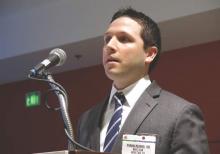SAN FRANCISCO – Delivering prophylactic therapies against venous thromboembolism sooner and to more patients admitted for trauma failed to reduce the risk of pulmonary embolism in a 6-year study of data on 23,863 patients.
Dr. Matthew J. Pommerening and his associates at the University of Texas, Houston, retrospectively studied data on the management and outcomes of 11,292 adults admitted to their level 1 trauma center in 2006-2008 before implementation of a performance-improvement program, and 12,571 patients admitted in 2009-2011, after the program was in place.
The performance-improvement program included sequential interventions such as audits for missed doses of thromboprophylactic medications, goals for earlier and more aggressive chemical prophylaxis, and placing prophylactic filters in the inferior vena cava (IVC) in high-risk patients.
Overall, 1% of patients developed a pulmonary embolism. Comparing rates of pulmonary emboli, deaths from pulmonary embolism, or mortality in the preprogram and postprogram time periods, however, showed no significant differences, he said at the annual clinical congress of the American College of Surgeons.
One percent of patients in both time periods developed a pulmonary embolism. The rate of death from pulmonary embolism was 7% in the earlier period and 8% in the later period. Mortality rates were 4.5% in both periods.
That’s despite great improvements in reducing the proportion of patients who got no prophylaxis from 45% in the earlier period to 11% under the improvement program. The use of prophylactic IVC filters increased from 3% in the earlier period to nearly 8% under the program. The time to initiation of prophylaxis decreased from 57 hours to 32 hours, on average.
The proportion of patients who missed a dose of thromboprophylaxis did not change significantly, from 39% in the earlier period to 36% under the program.
“Current prophylactic strategies and therapies for pulmonary embolism may be inadequate,” Dr. Pommerening said, perhaps due to inadequate dosing or inadequate therapies. The utility or potential thrombogenicity of IVC filters is a topic of “serious discussion” at his institution, he said.
“There’s still room for improvement,” he added, by eliminating missed doses and reducing the 11% of patients who got no prophylaxis, he added.
The time to diagnosis of pulmonary embolism and the proportion of emboli located in the main pulmonary artery did not differ significantly by time period.
The size of the study may not have provided enough power to detect differences in rates of emboli between time periods with such a low overall rate of pulmonary emboli to begin with, he said.
The investigators have started to look at whether the performance improvement program made any difference in the rate of deep-vein thrombosis.
Dr. Pommerening reported having no financial disclosures.
On Twitter @sherryboschert

